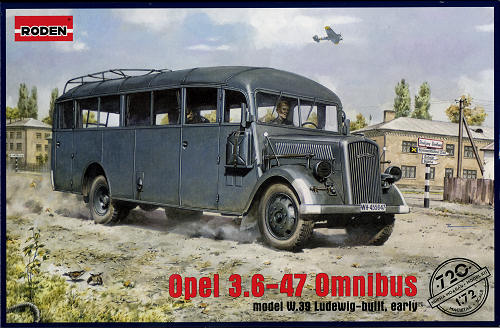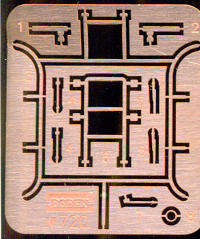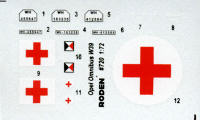
| KIT #: | 720 |
| PRICE: | $19.99 SRP |
| DECALS: | THhee options |
| REVIEWER: | Scott Van Aken |
| NOTES: | New tool kit |

| HISTORY |
Kit: In 1939 Germany was rapidly preparing for global hostilities. The plans of the German command supposed an instantaneous capture of quite large areas of other countries, and therefore special attention was paid to the question of the greatest possible motorization of infantry units. Besides a large number of different types of trucks which were already in the Wehrmacht's inventory, staff buses also began to be taken on charge, whose main task was the conveyance of officers during offensive actions of the army with a likely prospect of minimal resistance by an opposing party in the conflict.
The practice of building buses on a truck's chassis had existed for a long time, and therefore the most common types of buses which came into the German's inventory were based on the most widely used trucks. One of the most popular trucks at this time was the well-known Opel Blitz, and on its chassis was designed a standard army bus (at the time the more common term for it was "omnibus").
The Ludewig firm which was engaged in designing the bus, was located in Essen and had great experience in the manufacture of civilian multiseat vehicles. The standard chassis of the three ton truck was extended a little bit (up to 4450 mm), and the frame structure was reinforced. The original all-metal body of the new bus was quite elegant in outline, and only the front part where the engine was hidden, and the classic radiator with its distinctive logo, immediately reminded one of its predecessor, the famous "Blitz". Inside the cabin were several rows of seats which could be easily demounted if necessary (transportation of bulk goods, medical equipment, etc.).
Series production of the bus, officially designated the Opel 3.6-47 type W39, started in the second half of 1939, almost at the same time as the invasion of Poland by Germany and the start of WWII. At first, the number of vehicles produced per month was very small, but already in 1940 about one hundred units per month off were coming off the production line in Essen. Series production lasted until mid-1943, when the situation became worse for Germany at the Front, basic industrial materials were in short supply, and as a result, Ludewig had to seriously simplify the structure of the bus. During this period 2,880 units of the early version were produced overall, which were sent both to the Eastern Front in Russia, and to the Afrika Corps of General Rommel in North Africa.
In addition to its main purpose - the conveyance of Wehrmacht officers - buses had to perform various other functions such as those of mobile headquarters, telephone exchange and radio station, mobile bakery and laundry, etc. Special note should be made of their role in transporting
wounded from battlefield to hospital - rows of seats were removed and in their place several stretchers with wounded could be easily brought through the back door that opened into the interior, thus leaving space free for the installation of medical equipment.
Opel Blitz 3.6-47 buses were used by the army until the very end of the war, but immediately afterwards they quickly disappeared, giving way to more modern developments of the Opel concern during the early postwar years.
| THE KIT |
 Some of us really like esoteric things like this. Busses, bulldozers and staff cars are, to a cadre of modelers, more interesting than StuGs, Shermans, and Valentines. Roden realizes this and has
Some of us really like esoteric things like this. Busses, bulldozers and staff cars are, to a cadre of modelers, more interesting than StuGs, Shermans, and Valentines. Roden realizes this and has been doing a series of kits of the less than normal, which now includes a bus.
been doing a series of kits of the less than normal, which now includes a bus.
There are six nicely molded sprues of which two, for suspension bits and for seats, are duplicated. There is no clear sprue, but thanks to the flat windows, a piece of properly marked acetate will work just fine. There is also a small etched fret. The pieces on this fret are for the rear luggage rack and side mirrors. I found a few depressions on some thick pieces, but nothing that can't be fixed.
The body is built of mostly flat parts save the roof. I know that many would like a one-piece body, but really, it is easier to mold it in sections like this. The kit is not a curb side as it has a fully detailed engine (well, as fully detailed as you'd expect in this scale). Suspension bits are well done also and you get a nice one-piece ladder type chassis on which to fit these pieces. Under the chassis you'll fine a fuel tank, exhaust, and spare wheel. The interior contains a full set of seats for passengers and a near centrally mounted driver's seat. I should mention that several of the external bits need to have holes drilled. There are no pilot holes for these as on many kits, so you'll need to follow the kit instructions on placement.
 There are three markings options, in a variety of schemes. One is the box art bus in Panzer Grey. Another is in Desert Tan while a third is Panzer Yellow with Olive Green variegated stripes. This latter is an ambulance with most of the side windows painted white. It will be up to the builder on how to handle the seats in this last one as all options seem to have the standard passenger configuration. The Roden decals are nicely printed, but beware that their reputation is poor in terms of stick and their ability to conform to surfaces, so apply them accordingly.
There are three markings options, in a variety of schemes. One is the box art bus in Panzer Grey. Another is in Desert Tan while a third is Panzer Yellow with Olive Green variegated stripes. This latter is an ambulance with most of the side windows painted white. It will be up to the builder on how to handle the seats in this last one as all options seem to have the standard passenger configuration. The Roden decals are nicely printed, but beware that their reputation is poor in terms of stick and their ability to conform to surfaces, so apply them accordingly.
| CONCLUSIONS |
A very neat idea for a kit and thanks to its rather unusual subject, one that should be popular. If you recall the getaway scene in 'Where Eagles Dare', you'll recognize that were the movie based on fact, this would probably have been the bus so used. Unfortunately, none were available so a post war Austrian Graf and Stift bus was used instead. Thanks to several readers for helping to clarify that.
| REFERENCES |
The Roden web site.
August 2011
Thanks to Squadron Products for providing the preview kit. Get yours today at your local shop.
If you would like your product reviewed fairly and fairly quickly, please contact the editor or see other details in the